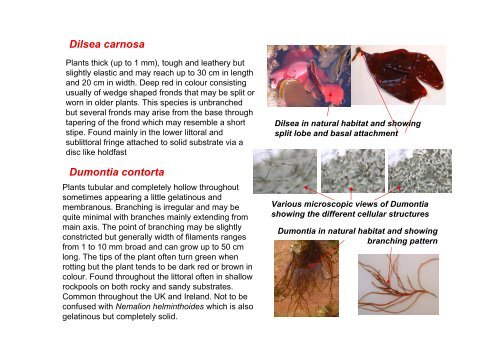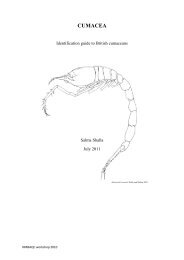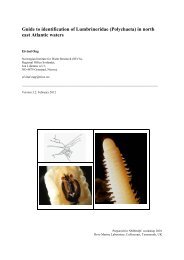s A Field Guide to the British Seaweeds - NMBAQC
s A Field Guide to the British Seaweeds - NMBAQC
s A Field Guide to the British Seaweeds - NMBAQC
You also want an ePaper? Increase the reach of your titles
YUMPU automatically turns print PDFs into web optimized ePapers that Google loves.
Dilsea carnosa<br />
Plants thick (up <strong>to</strong> 1 mm), <strong>to</strong>ugh and lea<strong>the</strong>ry but<br />
slightly elastic and may reach up <strong>to</strong> 30 cm in length<br />
and 20 cm in width. Deep red in colour consisting<br />
usually of wedge shaped fronds that may be split or<br />
worn in older plants. This species is unbranched<br />
but several fronds may arise from <strong>the</strong> base through<br />
tapering of <strong>the</strong> frond which may resemble a short<br />
stipe. Found mainly in <strong>the</strong> lower lit<strong>to</strong>ral and<br />
sublit<strong>to</strong>ral fringe attached <strong>to</strong> solid substrate via a<br />
disc like holdfast<br />
Dumontia con<strong>to</strong>rta<br />
Plants tubular and completely hollow throughout<br />
sometimes appearing a little gelatinous and<br />
membranous. Branching is irregular and may be<br />
quite minimal with branches mainly extending from<br />
main axis. The point of branching may be slightly<br />
constricted but generally width of filaments ranges<br />
from 1 <strong>to</strong> 10 mm broad and can grow up <strong>to</strong> 50 cm<br />
long. The tips of <strong>the</strong> plant often turn green when<br />
rotting but <strong>the</strong> plant tends <strong>to</strong> be dark red or brown in<br />
colour. Found throughout <strong>the</strong> lit<strong>to</strong>ral often in shallow<br />
rockpools on both rocky and sandy substrates.<br />
Common throughout <strong>the</strong> UK and Ireland. Not <strong>to</strong> be<br />
confused with Nemalion helminthoides which is also<br />
gelatinous but completely solid.<br />
Dilsea in natural habitat and showing<br />
split lobe and basal attachment<br />
Various microscopic views of Dumontia<br />
showing <strong>the</strong> different cellular structures<br />
Dumontia in natural habitat and showing<br />
branching pattern




